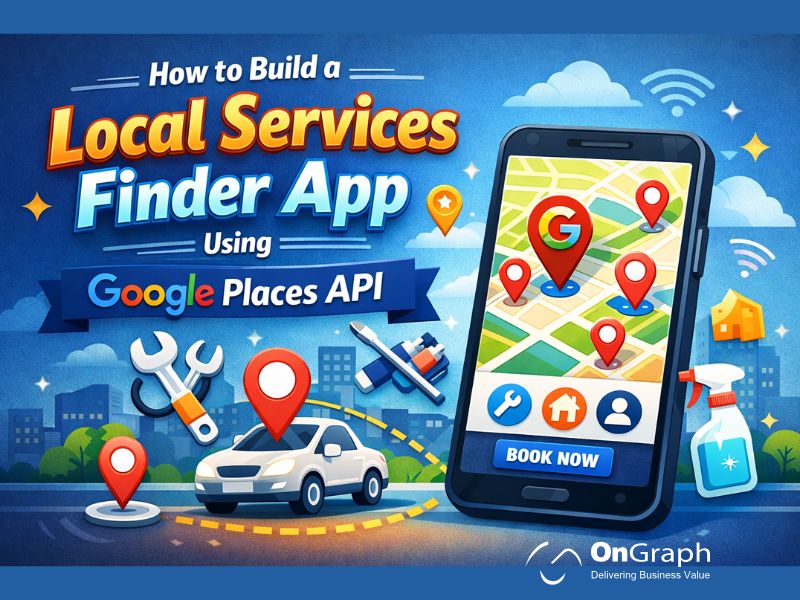In this article
- Why Car Rental Startups are Launching Taxi Apps?
- Core Benefits of Building a Taxi App for Car Rental Startups
- Modern Taxi App Features to Include in 2025
- Case Study: Launching a Taxi App for a Local Operator
- How to Build a Taxi App for Startups: Step-by-Step?
- Taxi App Development Cost in 2025
- Why Choose a Taxi App Development Company Like OnGraph
- Conclusion
In today’s on-demand economy, car rental businesses are fast evolving into mobility providers by building their own Taxi App for Local Car Rental Startups. This shift is being driven by the rising cost of third-party platforms like Uber and Ola, a lack of brand control, and a growing need for personalized customer experiences.
Whether you’re renting vehicles to gig economy drivers or offering local rides to urban customers, a scalable taxi app can help reduce operational inefficiencies, enhance customer loyalty, and increase profit margins. In this guide, we’ll break down the key components of launching a white-label taxi app tailored to local car rental operations in 2025.
Why Car Rental Startups are Launching Taxi Apps?
Car rental startups are recognizing that depending on ride-hailing giants is no longer sustainable. The commission-based model, lack of customer data ownership, and limited customization options are pushing local businesses to build their own apps.
Market Insight:
- The global ride-hailing market is projected to grow from $194 billion in 2022 to $386 billion by 2027 (Statista).
- White Label App Solutions are projected to grow at 17% CAGR, offering small businesses fast and cost-effective entry into the app-based mobility sector.
Core Benefits of Building a Taxi App for Car Rental Startups
1. Brand Control
Your own app allows you to showcase your branding, control the user experience, and manage customer communication directly.
2. Flexible Pricing & Promotions
Define region-wise pricing, custom commission structures, and ride discounts based on peak hours, cities, or user types—something off-the-shelf platforms won’t let you do.
3. Data Ownership
Having your own app ensures you retain valuable customer data to drive retention campaigns and service improvements.
4. Custom Features
You can integrate local payment gateways, in-app SOS alerts, government API checks, or features like “book with bodyguard” for extra security.
Modern Taxi App Features to Include in 2025
To stay ahead of competitors and offer an Uber-like (or better) experience, your taxi app must come packed with modern features. Here’s what you should include:
- Real-time ride tracking
- Driver scheduling and availability management
- Ride history and invoicing
- Scheduled rides and subscriptions
- SOS & emergency contact buttons
- Support for cash/card/wallet payments
- Admin dashboard for pricing and commission control
- City or region-based fare management
- Third-party integrations (payment gateways, CRM, etc.)
These modern taxi app features will enable local car rental startups to manage their fleet efficiently while enhancing rider experience.
Case Study: Launching a Taxi App for a Local Operator
A local car rental business operating in Australia wanted to stop paying high commissions to ride-hailing giants. They had a fleet of 30+ cars and served international students, gig workers, and residents across Melbourne.
Challenges:
- Reliance on Uber-like platforms
- No direct customer communication
- Lack of visibility into customer data
- High fees on global payment gateways
Solution:
The business adopted a white label taxi solution built on Flutter and PHP, integrated with local Australian payment providers and Google Maps. The solution included:
- Separate pricing for suburbs vs. city center
- Custom ride notifications
- Integration with local police SOS systems
- Two admin panels – business owner and city admin
Results:
- Saved 25% in operational costs
- Added 2000+ direct users within 3 months
- Gained full control over customer experience
- Seamless scaling into Sydney and Brisbane
This showcases how a taxi app development company can tailor a solution specifically for local needs, unlike cookie-cutter apps.
How to Build a Taxi App for Startups: Step-by-Step?
1. Define the Scope
Decide whether you’re targeting just rentals, ride-hailing, or a hybrid model (taxi + delivery + hourly rentals). Some opt to build a multi-service travel app to expand revenue.
2. Choose a Tech Stack
Most modern apps use Flutter for cross-platform app development, along with PHP or Node.js for the backend.
3. Go for White Label App Solutions
It reduces development time and cost significantly. You get a working base that’s easily customized.
4. Integrate Local APIs
Include local payment providers, verification systems, or emergency hotlines for added trust.
5. Test, Deploy, and Scale
After a successful MVP launch in your city or town, use the same backend to expand to other locations—no rebuild needed.
Taxi App Development Cost in 2025
Depending on the complexity and level of customization, the taxi app development cost may vary. Here’s a breakdown:
| Component | Estimated Cost (USD) |
| White Label App License | $5,000 – $8,000 |
| Custom Features & Integration | $1,500 – $3,000 |
| Backend & Admin Panel Setup | Included |
| iOS + Android App Delivery | Included |
| Support & Maintenance (2 months) | Included |
| Optional Annual Support | ~$300/month |
Note: Costs vary based on region and scope. Many ride-hailing app development companies offer milestone-based payments (e.g., 25%-25%-40%-10%).
Why Choose a Taxi App Development Company Like OnGraph?
As an experienced taxi app development company, we specialize in:
- Custom white label taxi apps
- Ready-to-deploy MVPs
- Integrations with region-specific APIs
- Post-launch support and scaling
Whether you’re launching in Australia, Africa, the UK, or India, our team ensures your product is compliant, modern, and scalable.
Conclusion
Launching a Taxi App for Local Car Rental Startups is not just a digital transformation—it’s a business necessity in 2025. With a tailored, white-label solution, local businesses can break free from third-party platforms, reclaim their customers, and scale across cities without burning a hole in their pocket.The future of car rental is app-first. The time to act is now.
FAQs
A White Label Taxi Solution is a ready-made taxi booking software that can be customized and rebranded with your own logo, colors, features, and domain. For car rental startups, this means:
- Faster go-to-market with a pre-built foundation
- Reduced development costs
- No need to build from scratch
- Full ownership of customer data and platform
- Freedom to integrate local payment gateways, safety tools, or admin logic as per business needs
It enables startups to compete with large ride-hailing apps without massive technical investments.
The Taxi App Development Cost in 2025 depends on the scope, features, and level of customization. A standard white-label app can cost between $5,000 and $8,000. Additional costs may include:
- Custom integrations: $1,500–$3,000
- Annual maintenance or support (post-launch): ~$300/month
- App store fees (for iOS/Android): As per platform
Startups can choose milestone-based payments to manage their budget effectively.
A modern taxi app should go beyond basic booking. Essential features include:
- Real-time GPS-based ride tracking
- Multi-region pricing (city or area-wise)
- SOS emergency alerts with custom contact
- Scheduled rides and subscriptions
- Driver onboarding & verification
- Admin dashboard to manage pricing, users, and commissions
- Multiple payment options (cash, card, wallet)
- Notification system (SMS, push, email)
- Support for iOS and Android (via Flutter)
These features ensure operational efficiency and a seamless customer experience.
Yes, a scalable taxi app built using technologies like Flutter and PHP can integrate with any local or international payment gateway, such as:
- Stripe
- Razorpay
- PayU
- Local zero-commission providers in countries like Australia
Custom payment integrations typically take 2–4 days, depending on API documentation and business rules.
Absolutely. A properly built ride-hailing app development framework allows:
- City-wise configuration for pricing, taxes, commissions, and car types
- Separate admin access per region or franchise
- Support for adding or deactivating cities from the backend
- Fare logic customization based on traffic, waiting time, distance, etc.
This is critical for startups planning to expand from one city to another in the future.
With a white label app solution, the average launch time is between 3 to 5 weeks, depending on:
- Number of required customizations
- UI/UX redesign preferences
- API integration needs (payment, verification, etc.)
- App store approval time (especially for iOS TestFlight)
This is significantly faster than building an app from scratch, which can take 3–6 months or more.
Not necessarily. Once your app is live, most white label taxi solutions include:
- A simple admin panel with no-code features
- Two months of post-launch technical support (usually included in the cost)
- Documentation and knowledge transfer (KT) for in-house or external developers
However, having a technical advisor or part-time developer is recommended if you plan to add advanced features or integrations regularly.
About the Author
Let’s Create Something Great Together!
Latest Blog
















